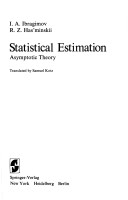Stochastic Modelling and Applied Probability
2 primary works
Book 16
Statistical Estimation Asymptotic Theory
by I a Ibragimov and R Z Has'minskii
Book 66
Since the publication of the first edition of the present volume in 1980, the stochastic stability of differential equations has become a very popular subject of research in mathematics and engineering. To date exact formulas for the Lyapunov exponent, the criteria for the moment and almost sure stability, and for the existence of stationary and periodic solutions of stochastic differential equations have been widely used in the literature. In this updated volume readers will find important new results on the moment Lyapunov exponent, stability index and some other fields, obtained after publication of the first edition, and a significantly expanded bibliography.
This volume provides a solid foundation for students in graduate courses in mathematics and its applications. It is also useful for those researchers who would like to learn more about this subject, to start their research in this area or to study the properties of concrete mechanical systems subjected to random perturbations.

